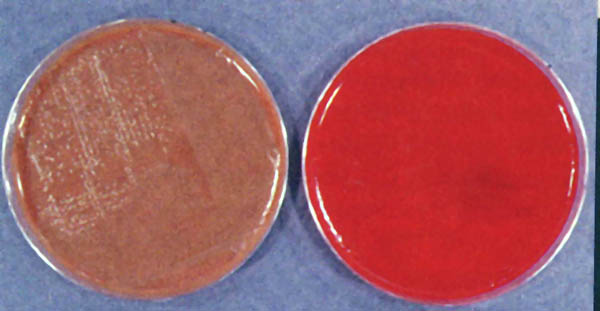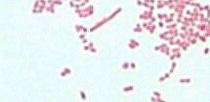|
|
|
 |
 |
The patient's mental status did not improve overnight, and a lumbar
puncture was performed which showed a cerebrospinal fluid (CSF) white blood
cell (WBC) count of 4,650/ml with 95% neutrophils,
glucose 48 mg/dl (normal, 50 to 75 mg/dl), and a protein of 107 mg/dl (normal,
15 to 45 mg/dl). Overnight his peripheral WBC count had increased from
6,600 to 14,600 cell per ml. Another physical
examination revealed the patient to be irritable, and to have a stiff neck.
Another blood culture was positive. There was concern the patient was immunosuppressed.
Immunoglobulin levels, complement levels, and lymphocyte function test
results were obtained. All the immune function tests were within normal
ranges. CSF samples were grown on blood agar plates and chocolate agar
plates (see result below). Gram stain of the organism
grown from the blood culture is below.
|
|
|
 |
 |
1. Which of the following is the best description of the child's CSF?
a. normal WBC count, normal glucose, normal protein.
b. high WBC count, high glucose, low protein.
c. high WBC count, low glucose, high protein.
d. low WBC count, high glucose, low protein.
e. low WBC count, low glucose, high protein.
2. Results from the CSF are indicative of infection with which of the
following?
a. viruses
b. fungi
c. bacteria
d. protozoan parasites
3. Name the child's disease (ex. pneumonia, croup) and the etiologic agent (e.g. genus and species, Streptococcus pneumoniae) causing the child's disease.
Answers to the questions can be obtained by clicking on this following link: answers.
Take Care and Think Microbiologically!
Neal R. Chamberlain, Ph.D.

Hum. Only grows on chocolate ;)

A pleomorphic gram negative rod that only grows on chocolate!? THINK Haemophilus.
Answers 1= C; 2= C; and 3= Meningitis; Haemophilus influenzae
This site is maintained by Neal R. Chamberlain, Ph.D., and was last revised 7/13/18.
Comments can be emailed to: nchamberlain@atsu.edu
Copyright© 2002-2009, A.T. Still University/ Kirksville College of Osteopathic Medicine, Kirksville MO.